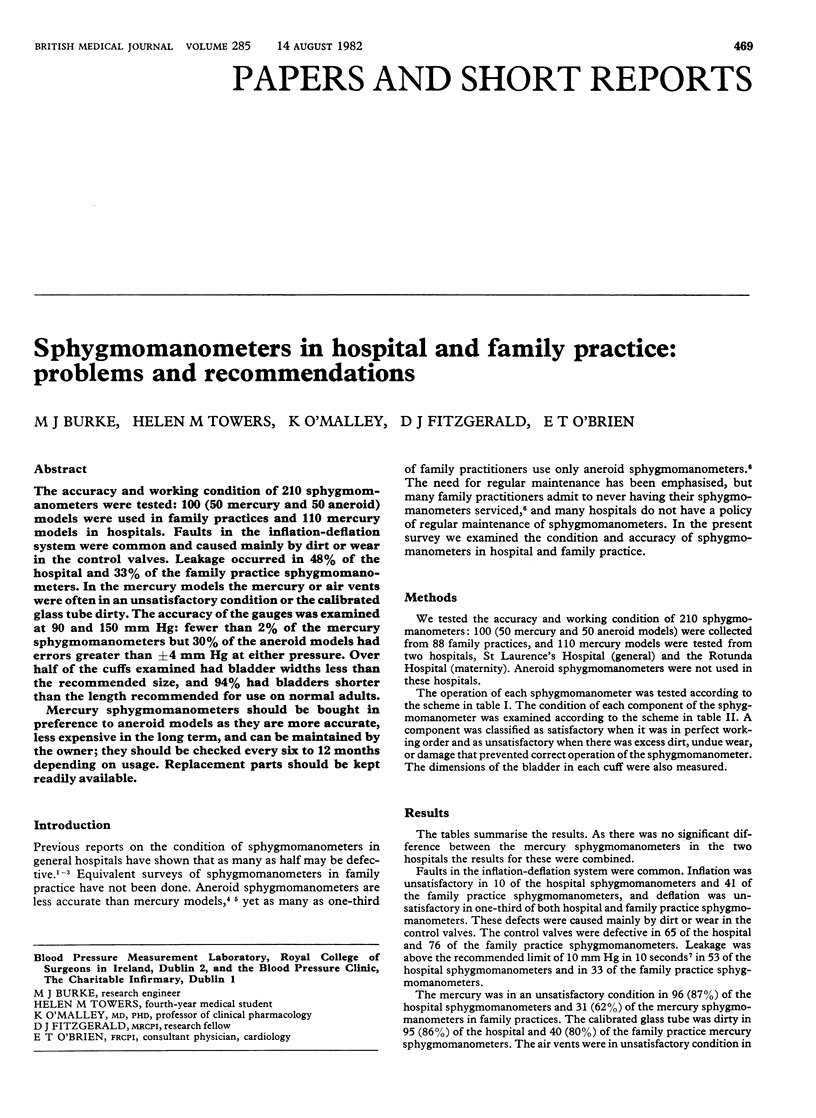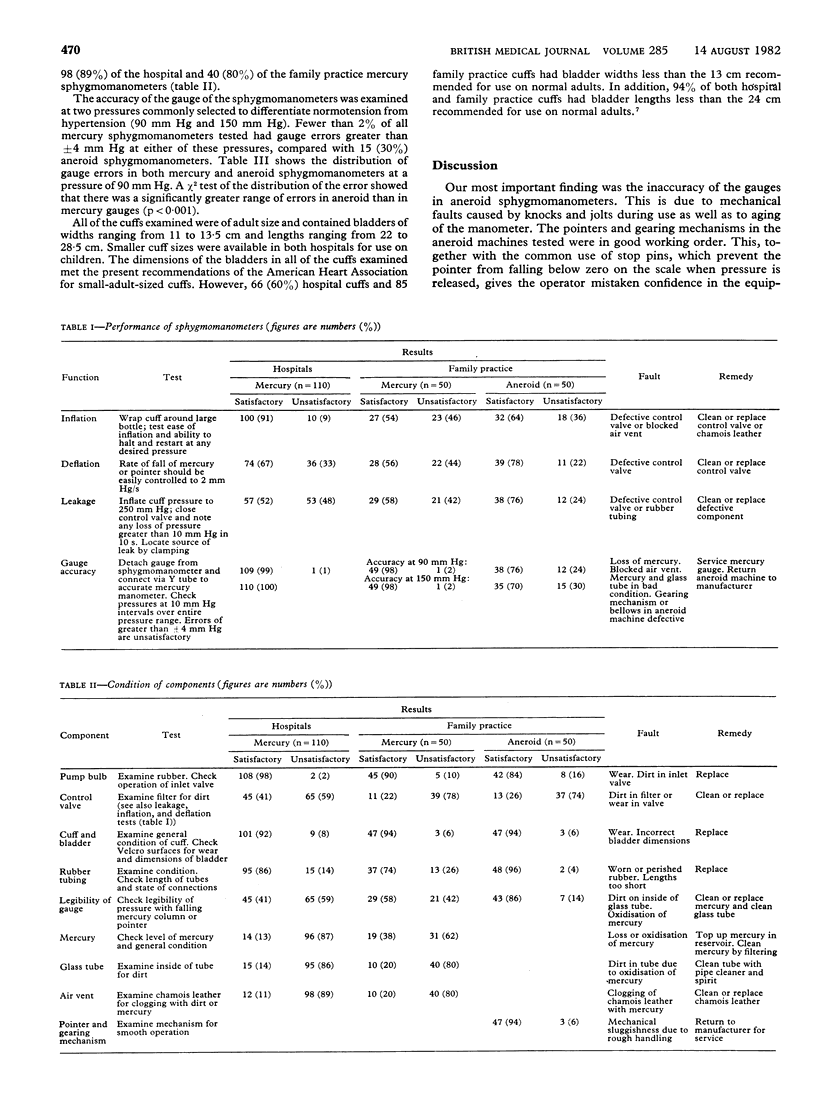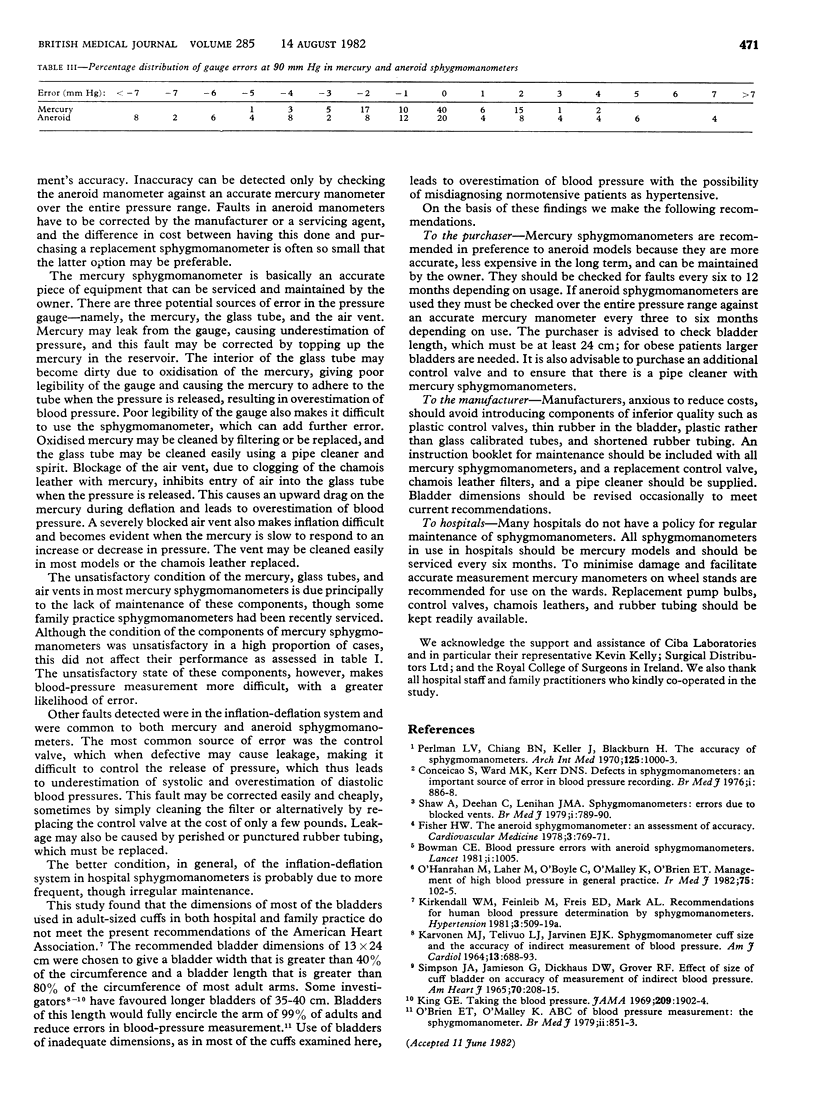Abstract
The accuracy and working condition of 210 sphygmomanometers were tested: 100 (50 and mercury and 50 aneroid) models were used in family practices and 100 mercury models in hospitals. Faults in the inflation-deflation system were common and caused mainly by dirt or wear in the control valves. Leakage occurred in 48% of the hospital and 33% of the family practice sphygmomanometers. In the mercury models the mercury or air vents were often in an unsatisfactory condition or the calibrated glass tube dirty. The accuracy of the gauges was examined at 90 and 150 mm Hg: fewer than 2% of the mercury sphygmomanometers but 30% of the aneroid models had errors greater than +/- 4 mm Hg at either pressure. Over half of the cuffs examined had bladders widths less than the recommended size, and 94% had bladders shorter than the length recommended for use on normal adults. Mercury sphygmomanometers should be bought in preference to aneroid models as they are more accurate, less expensive in the long term, and can be maintained by the owner; they should be checked every six to 12 months depending on usage. Replacement parts should be kept readily available.
Full text
PDF


Selected References
These references are in PubMed. This may not be the complete list of references from this article.
- Bowman C. E. Blood pressure errors with aneroid sphygmomanometers. Lancet. 1981 May 2;1(8227):1005–1005. doi: 10.1016/s0140-6736(81)91776-1. [DOI] [PubMed] [Google Scholar]
- Chang J. J., Kisaragi M., Okamoto H., Inagami T. Isolation and activation of inactive renin from human kidney and plasma. Plasma and renal inactive renins have different molecular weights. Hypertension. 1981 Sep-Oct;3(5):509–515. doi: 10.1161/01.hyp.3.5.509. [DOI] [PubMed] [Google Scholar]
- Conceiçao S., Ward M. K., Kerr D. N. Defects in sphygmomanometers: an important source of error in blood pressure recording. Br Med J. 1976 Apr 10;1(6014):886–888. doi: 10.1136/bmj.1.6014.886. [DOI] [PMC free article] [PubMed] [Google Scholar]
- KARVONEN M. J., TELIVUO L. J., JAERVINEN E. J. SPHYGOMOMANOMETER CUFF SIZE AND THE ACCURACY OF INDIRECT MEASUREMENT OF BLOOD PRESSURE. Am J Cardiol. 1964 May;13:688–693. doi: 10.1016/0002-9149(64)90206-1. [DOI] [PubMed] [Google Scholar]
- King G. E. Taking the blood pressure. JAMA. 1969 Sep 22;209(12):1902–1904. [PubMed] [Google Scholar]
- O'Brien E. T., O'Malley K. The sphygmomanometer. Br Med J. 1979 Oct 6;2(6194):851–853. doi: 10.1136/bmj.2.6194.851. [DOI] [PMC free article] [PubMed] [Google Scholar]
- O'Hanrahan M., Laher M., O'Boyle C., O'Malley K., O'Brien E. T. Management of high blood pressure in general practice. Ir Med J. 1982 Apr;75(4):102–105. [PubMed] [Google Scholar]
- Perlman L. V., Chiang B. N., Keller J., Blackburn H. Accuracy of sphygmomanometers in hospital practice. Arch Intern Med. 1970 Jun;125(6):1000–1003. [PubMed] [Google Scholar]
- SIMPSON J. A., JAMIESON G., DICKHAUS D. W., GROVER R. F. EFFECT OF SIZE OF CUFF BLADDER ON ACCURACY OF MEASUREMENT OF INDIRECT BLOOD PRESSURE. Am Heart J. 1965 Aug;70:208–215. doi: 10.1016/0002-8703(65)90069-4. [DOI] [PubMed] [Google Scholar]
- Shaw A., Deehan C., Lenihan J. M. Sphygmomanometers: errors due to blocked vents. Br Med J. 1979 Mar 24;1(6166):789–790. doi: 10.1136/bmj.1.6166.789. [DOI] [PMC free article] [PubMed] [Google Scholar]


